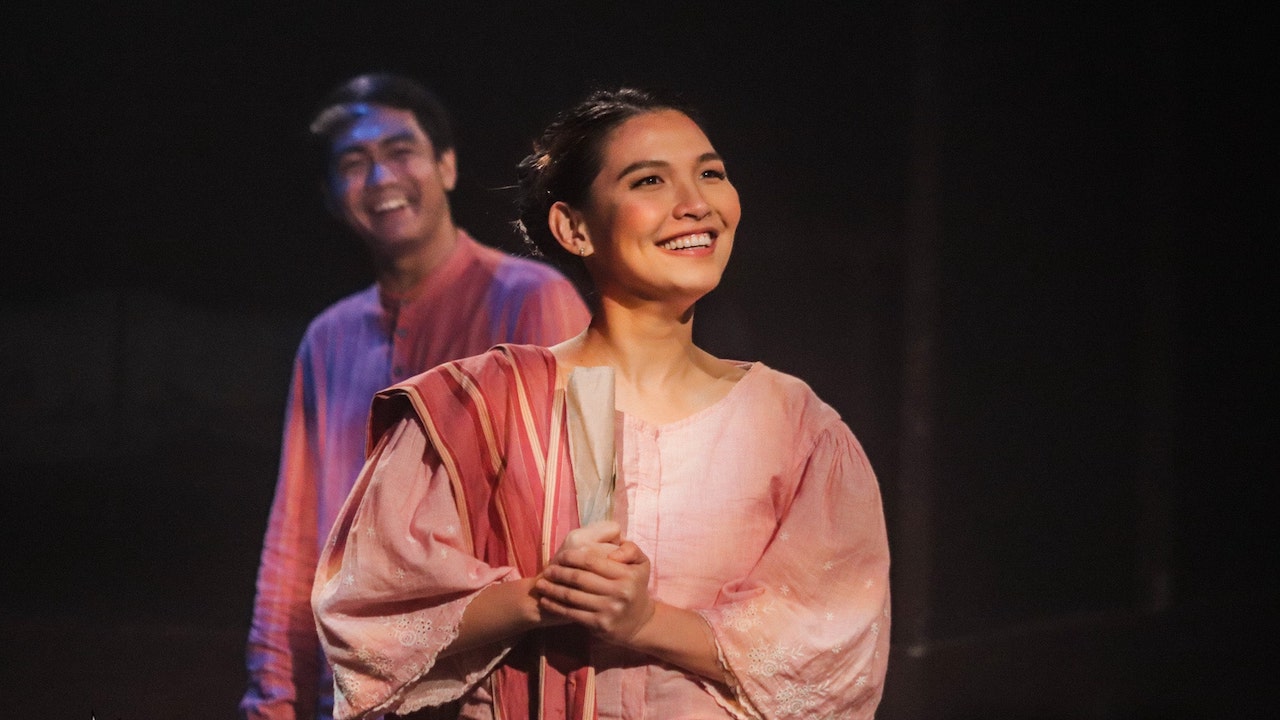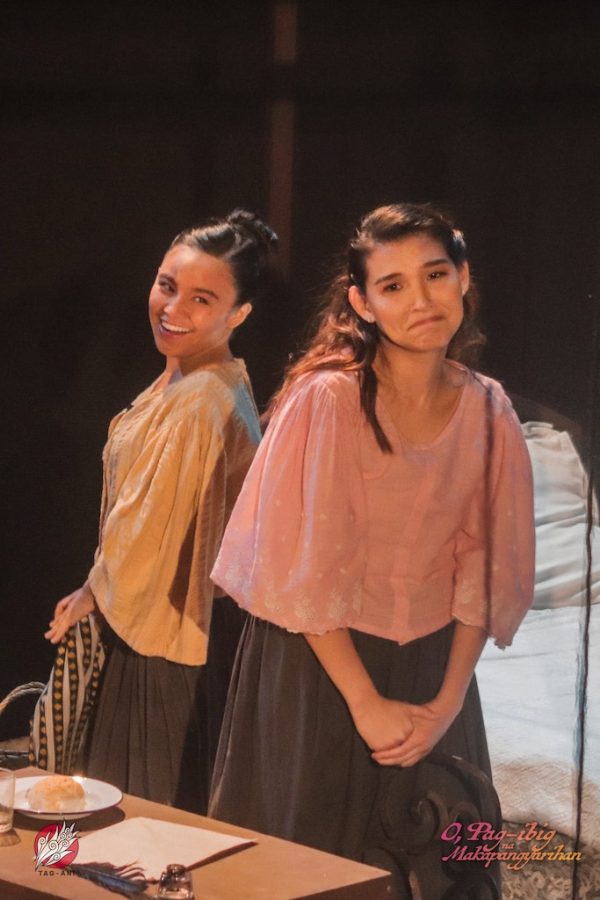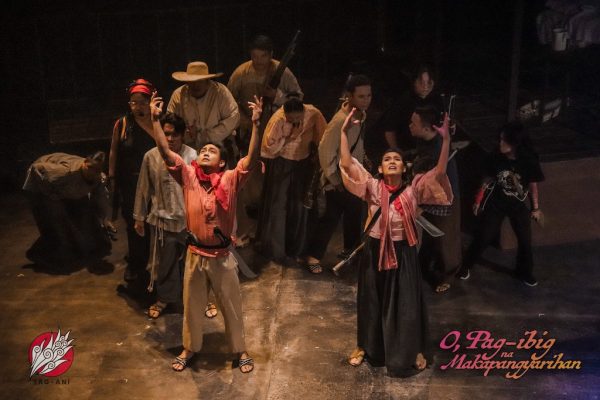
REVIEW: ‘O, Pag-ibig na Makapangyarihan’ is a deeper love story masked as historical ‘teen’ romance
“It’s a production that wants its audience to reflect on our past—whether it’s our national heroes’ sacrifices for the revolution or the decades-long Philippine dictatorship people seem to have so casually forgotten about.”
A period romance with key historical figures for Valentine’s season? This hopeless romantic writer would like to be counted in. The love story also aims to talk about something much bigger and revolutionary? Even better.
Written and directed by Bonifacio P. Ilagan, O, Pag-ibig na Makapangyarihan takes its audience back to 1893, to Gregoria “Oryang” De Jesus’ (Pau Benitez) and Andres Bonifacio’s (Johnny Maglinao) love story during the brink of revolution. Oryang’s parents (Astarte Abraham and Greg De Leon) are unhappy with the relationship and are willing to go to extreme lengths to separate the two. Meanwhile, a fictional character named Remigia (Angellie Sanoy) serves as the story’s resident Gen Z narrator, providing her insights, much-needed “translations”, and hilarious reactions along the way.
The deeper love story
Ilagan’s vision of the show reminds this writer of the fantasy television show Maria Clara at Ibarra, which took historical lessons from Jose Rizal’s novels and adapted them into a relatable story for the youth.
At first, it would seem like O, Pag-ibig na Makapangyarihan’s main focus is a brief but pivotal moment in Oryang and Andres’ love story. She was just another lovestruck teenager feeling like it was the “end of the world” when her parents aimed to separate them. But the obedient, traditional Oryang eventually questioned authority, found her voice, and even encouraged her fellow dalagang pilipina Remigia to think for herself.
It was through Remigia and her side comments as narrator that the play’s deeper message is revealed: the character showed that history is repeating itself and that it is time for action. Her use of Gen-Z slang further highlighted that the issues our national heroes were facing back then are not that different from the present. The play also did not hesitate to reference the current administration and its ongoing political circus.

L-R: Angellie Sanoy as Remigia and Pau Benitez as Oryang; Photo Credit: Tag-Ani Performing Arts Society
For example, early in the story Remigia concluded that Andres and his comrades—with their progressive ideas and their newly-built organization Katipunan—would certainly be red-tagged today. She also questioned why the term “revolution” has a negative meaning until now, when all the revolutionaries have ever wanted is the good of their country. It was through her eyes that the audience saw Andres and Oryang as the Katipunan’s Supremo and Lakambini, determined to free their countrymen from opportunists and the corrupt.
Though the production’s tone was often light, its serious themes were evident.
Through Remigia, the play talked about a much bigger love story—that of the characters’ love for their country. Ilagan as writer and director also highlighted that revolution isn’t rooted in violence and bloodshed but in love—love for one’s romantic partner, one’s family, and one’s countrymen.
Kilig and history in one

Johnny Maglinao as Andres Bonifacio and Benitez as Oryang with the cast of O, Pag-ibig na Makapangyarihan; Photo Credit: Tag-Ani Performing Arts Society
No doubt about it: Oryang and Andres’ courting scenes were also truly nakakakilig, thanks to Benitez’ portrayal of the young, love-struck Oryang. Benitez understood the character’s initially shy but flirty nature, which later progressed into her being the story’s hesitant but opinionated lead. Maglinao’s Andres was an earnest, lovestruck beau, and he was equally determined as a revolutionary leader.
Sanoy’s Remigia also shone. Breaking the fourth wall (which the character did throughout the show) is never easy, but Sanoy did it flawlessly. Another notable character was Ahmed Maulana’s Igme. In the show, we saw Igme trying–and failing–to fit a certain male stereotype, which this generation can certainly relate to.
A few drawbacks
One has to take a second look at Andres and Oryang’s 11-year age gap, which was the main reason why the latter’s parents were against the relationship in the first place. The play acknowledged this fact, but it still left a bad taste in the mouth because Oryang was underage.
With a running time of almost two hours, the story’s pacing was a little slow —even more so considering that the target audience is a younger generation with a sadly limited attention span. Some sound cues were also delayed, jolting this writer back to the present and the fact that I was actually watching a play. And while I greatly appreciated that humor was injected into the story, some jokes did not land that well, leaving me confused as to whether it was actually time to laugh or not.
Meanwhile, the production’s lighting (Geraldine Corpus) complemented the minimalist set (by Ohm David) and gave the show a dreamy, period-drama-like ambiance. This writer particularly liked the Capiz-like windows serving as the show’s backdrop.
Getting the point across
It’s a production that wants its audience to reflect on our past—whether it’s our national heroes’ sacrifices for the revolution or the decades-long Philippine dictatorship people seem to have so casually forgotten about.
While improvements could be made, O, Pag-ibig na Makapangyarihan in its way delivered its message. The lessons from the show are not new, for sure, but they are still essential in this era of misinformation, online trolls, and historical revisionism.
Tickets: Php 500 – Php 800
Show Dates: February 7 – 23, 2025; March 8–9, 2025
Venue: Ignacio B. Gimenez – Kolehiyo ng Arte at Literatura Theater, UP Diliman and Erehwon Center for the Arts
Running Time: 1 hour and 50 minutes (with a 10-minute intermission)
Company: Tag-Ani Performing Arts Society
Creatives: Bonifacio P. Ilagan (Playwright and Director), Brian Arda (Associate Director), Ohm David (Production Designer), Geraldine Corpus (Lighting Designer), Carlo Bernardino (Sound Designer), Satya Edilo (Technical Director), Jigger Sementilla (Assistant Technical Director), Angge Santos, Patricia David, Chester Curso, Sheryl Leynes, and Hiedi Veronica Cortejo (Production Management Team), Brian Arda, Ashe Reposo, Hyojin Kim, Ayesha Domingo, Mikaila Fortaliza, Caira Figues, and Mayvelyn Laugo (Stage Management Team), Astarte Abraham (Mime Coach and Movement Director), Joshua “Kang” Orbasibo (Choreographer), Clem David Jumawan and Axel Limjoco (Technical Team), Paolo Lorenzo and Gale Bathan (Graphics), Xian Guevarra, Karen Tausing, Myke Catalino, and Oliver Ayson (Marketing and Promotions), Cha Reyes (Hair and Make-up), Rodney Flores (Photography), and Xian Guevarra and Patricia David (Front of House)
Cast: Angellie Sanoy (Remigia), Pau Benitez (Oryang), Nel Estuya (Bonifacio), Johnny Maglinao (Bonifacio), Astarte Abraham (Nanay Baltazara, ina ni Oryang), Greg De Leon (Tatay Nicolas, ama ni Oryang), Sheryl Leynes (Comadre), Jocelyn Salvania (Comadre), Jers Guiwa (Compadre), Ian Lomongo (Compadre), Ahmed Maulana (Igme), Ace Hernandez (Islao), Edward Allen Solon (Doro), Joseph Briez (Asistente), Francel Go (Katipunera), Angelica Marcelino (Katipunera), and Chester Curso (Guardia Civil)


Comments